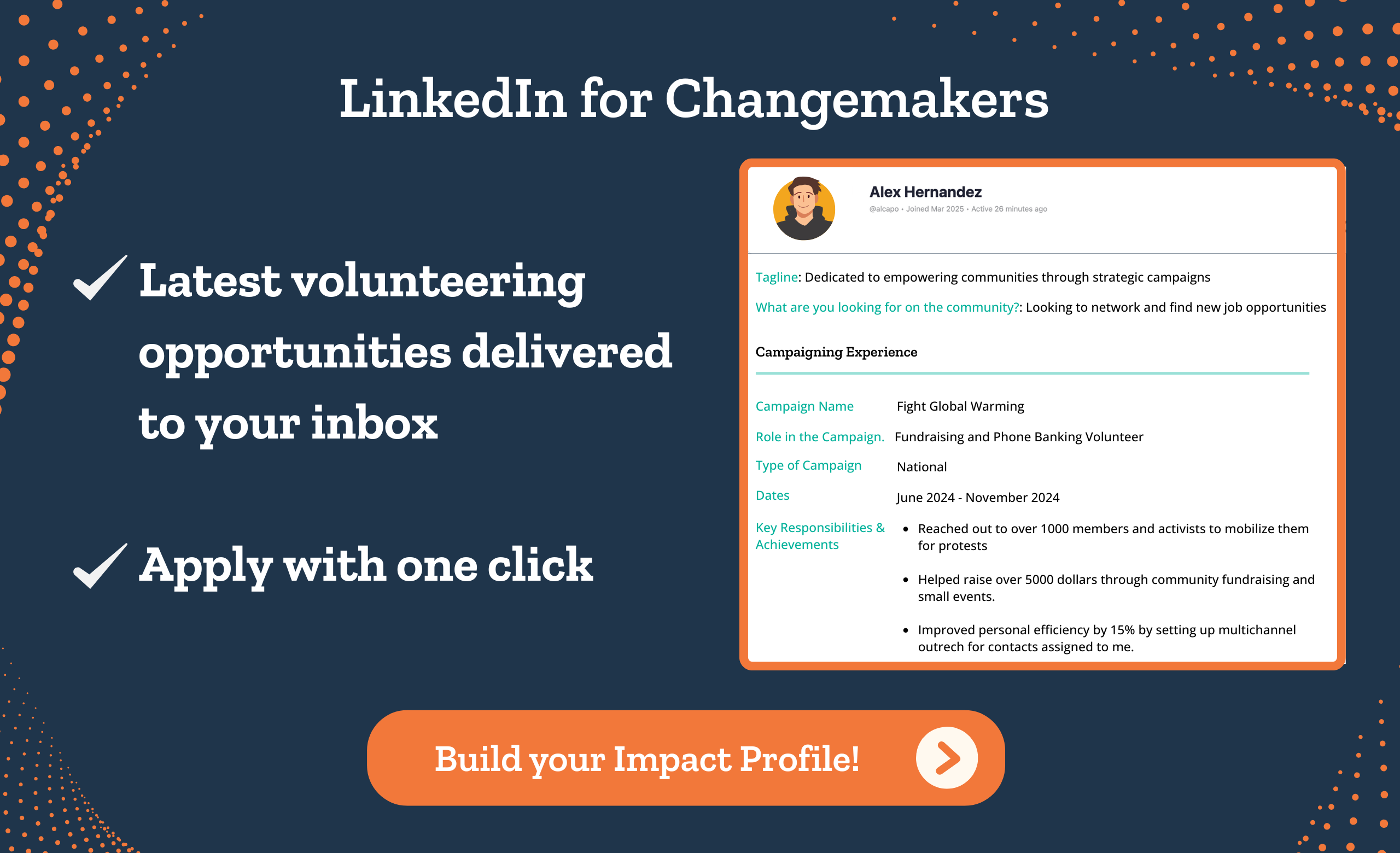Table of Contents
Advocacy campaigns have been the cornerstone on which society has continuously progressed. We explore 4 advocacy campaign examples that inspired us immensely.
It was more than 50 years ago when a group of roughly 100 women marched against the Miss America Beauty pageant.
“We were young radicals, just discovering feminism because we were tired of making coffee but not policy”
Robin Morgan, An organizer of the protest
The iconic march is remembered for the women rejecting makeup, bras, and anything that made them conform to a stereotypical beauty (they threw it into a Freedom Trash Can. And no, there were no bra burnings).
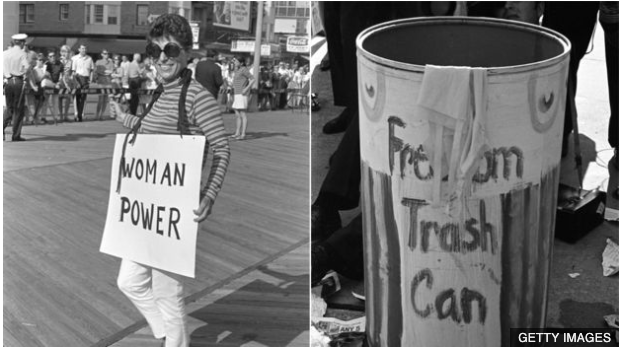
Fast forward to now, and not much has changed.
Women took to the streets in 2017 to protest inequality in society and fight for equal rights. It was a powerful movement, one among successful advocacy examples, and again would doubtlessly go down in history as ‘iconic’.
But there was something fundamentally different about this protest.
- The protests were not limited to just one area. Women in Sydney, London, Paris, Berlin, and even Antarctica took to the streets to register their dissent.
- The protesters also were huge in number! 500,000 women joined the protest in DC (more than double the initial estimate), and about 750,000 women were estimated to have joined the LA rally.
What made this protest such a success? What had changed from the 1950s to 2017 that enabled so many women not just to participate in public advocacy campaigns but also coordinate their protests?
The answer – Social media.
Take a look at the top social media channels used by advocacy campaigns:
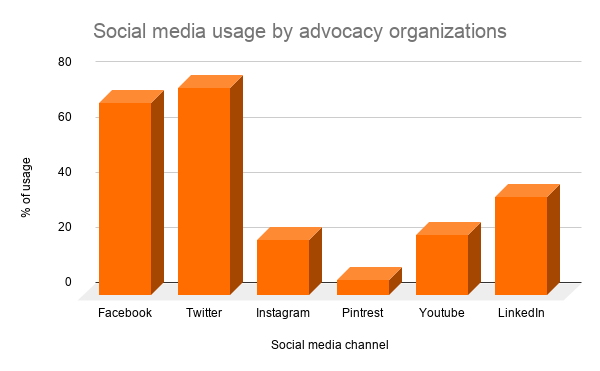
Successful advocacy advertising campaigns have always had social media boosting them.
So, in this post, while we take a look at a few awesome advocacy campaign examples, we will also look at how social media helped them become big.
How does social media help advocacy campaigns?
It is important to understand that social media activism (Hashtag activism) can never replace traditional protests.
Peaceful gatherings to register dissent, marching together against a joint goal, etc., still have as much impact as they once did.
What social media has done for advocacy activities is provide an opportunity to reach more people who think alike and thus amplify their voices.
Here are a few examples of how social media has helped unite people over a common issue.
1. Provides a common platform to share stories for advocacy campaigns
In September 2014, a viral video of Ray Rice (a former running back) of Baltimore Ravens assaulting his wife and dragging her unconscious body in an elevator sparked a critical debate on the internet:
“Why can’t the victims of domestic abuse just leave?”
Though posed as a simple question, it was obvious that there was a deeper problem. Those debating simply did not know what a victim (or survivor) actually faces.
More importantly, they assumed that a woman can ensure her safety by simply leaving a violent relationship.
Beverley Gooden (an author and just another internet user) decided to tell the other side of the story – her story.
She used #WhyIStayed on Twitter, to tell the world why ‘just leaving’ isn’t so easy for someone in an abusive relationship.
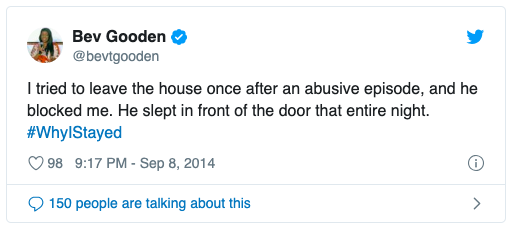
The result? It sparked a floodgate of tweets from women all over the world. They came together and shared their personal stories online.
It was one of the largest survivor-led political campaigns movements. TIMES called it one of the Top 10 hashtags that started a conversation!
While it took a lot of courage for the women to come out and share their stories, it was possible because they had a common platform to do it in!
Twitter (social media) provided them with a place where they could vent, be heard, and get a response.
The result? #WhyIStayed is now an advocacy campaign that helps and rallies for women in abusive relationships. And it all started because courageous survivors used social media to share.
You May Also Like: The All-In-One Political Advocacy Guide To Begin Your Activism
2. Quicker turnaround time
The next example of advocacy of how social media helped the world is not so dark, but just as important.
WWF ran an ingenious advocacy campaign on Snapchat. They used the ‘timed messages’ feature on Snapchat to share selfies of endangered species across the world.
Each of those messages would be on for 10 seconds (timed, remember?). But before the messages faded, they would urge the user to share the message, adopt an animal, or make a donation.
The response to the campaign was overwhelming! Not only did it raise awareness about wildlife conservation among millennials, but it also encouraged them to act.
Here is how quickly WWF raise money for their monthly target:
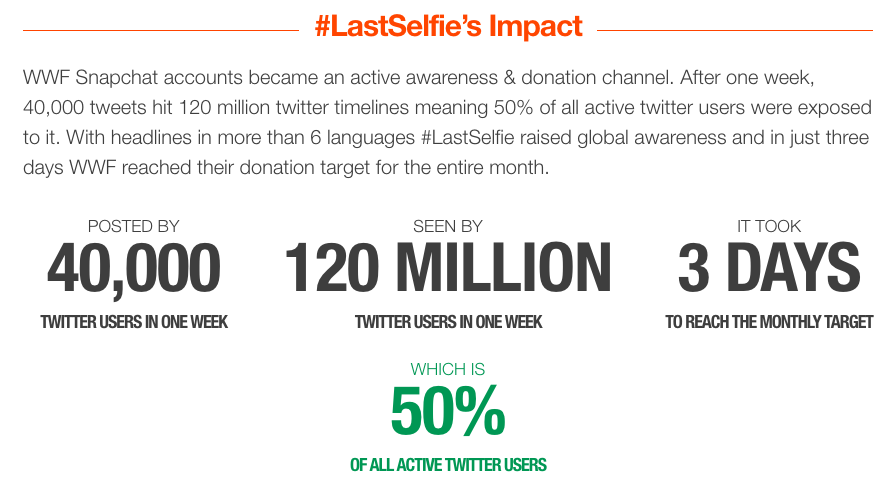
The success of the campaign is undoubtedly due to how intelligent it was. It struck a chord with audiences across the globe because it used a social media feature to get its message across. It is an advocacy campaign example of its kind.
However, even the most successful campaigns do not see such instantaneous results. Social media enabled the users to respond quickly to the campaign, thus meeting their goals.
3. Encourages solidarity for advocacy campaigns
A common thread in both the above advocacy examples you read is this: fact on social media inspire action to right a wrong.
Both #WhyIStayed and #LastSelfie were based on rectifying a perception (of abuse victims) and an inevitable outcome (extinction).
This successful advocacy campaign example is a bit different. It is about how social media helped people stand together in the face of violence.
A little before the Christmas of 2015, London saw a man (under heavy psychiatric distress) slit the throat of a stranger on a subway.
Justice was swiftly served – he was sentenced to life in a maximum-security mental health center.
But it was not before a video of the actual incident was made public on social media. Countless Twitterati’s watched as an innocent man was taken down by pure hate.
In today’s unfortunate world, this incident would have been an opportunity to spread some hate. It definitely would have given rise to anti-Islamic sentiments and discrimination.
London surprised us there (thankfully!). The first comment on that video was by a young man who said, #YouAintNoMuslimBruv.
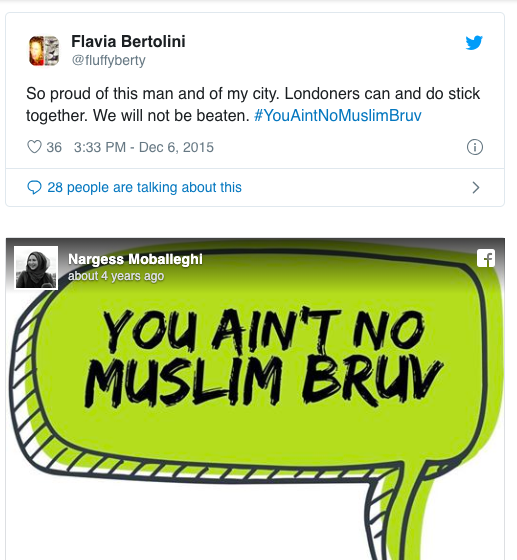
The sentiment and the hashtag resonated not just with Muslims but with audiences across the globe.
Hundreds of people used the same tweet to stand in solidarity with the message and stood up. As an article rightly pointed out – terror does not have a religion. It most definitely is not Islamic.
Thankfully social media was there to help people register that fact. It was a platform that enabled numerous people to stand behind one advocacy campaign idea and show solidarity.
These examples drive home a simple fact. While people are the ones who drive an advocacy campaign, social media is an amazing tool that can help shape its success.
Read Next: Advocacy Advertising – The Best Channels to Engage Audiences
Are there downsides to advocacy campaigns using social media?
It should be noted that not Hashtag activism is not always this successful. For instance, the movement #BringBackOurGirls did not result in Boko Haram releasing the 200 girls he kidnapped.
What it did do is bring attention to the injustices suffered by women (and children) in a small town in Nigeria.
Without social media, it is safe to say that their struggles wouldn’t be noticed instantaneously.
So yes, social media is great to rasie awareness for your cause. Still, there are certain downsides to this social media activism.
1. Cluttered content (very hard for some causes to be heard)
Some of the hashtags are so overused (and trolled) that it is quite tough for a fledgling organization to be heard over the noise.
Unless the organization has a social media expert on their team or by chance, gets the attention of a celebrity (and thus goes viral), they cannot cut through the excessive content and be heard.
2. No set way to measure the impact
For an organization to seriously initiate a social media advocacy campaign for its cause, they must define metrics. Otherwise, it will be impossible to keep funneling resources into that channel.
Unfortunately, it is tricky to define the impact social media has on a cause. Measuring likes, shares and comments are all well and good.
But they do not tell advocacy organizations which channel had the most impact in bringing them donors, or to what extent social media helped in boosting attendance for an event.
Without such hard numbers, it is difficult for small organizations to spend their funds on one channel constantly.
3. Does not give you another point of view
From an individual’s perspective, social media doesn’t help in encouraging conversation about an issue. Movements like #WhyIStayed and #MeToo are few and far between.
In general, since all the algorithms are designed to show users content based on what they like, they live ‘in a bubble’ that only echoes their thoughts.
So it is close to impossible for an organization to reach out to a non-supporter and convince him of their cause.
While these are downsides to keep in mind, it does not mean that you ignore social media entirely. These excellent advocacy campaign examples will show you how to use social media right for your campaign.
Best of the advocacy campaign examples
The examples of activism we saw above were those that were strictly powered through social media. Though it can raise awareness and encouraged people to act, these movements were not combined with mainstream (or traditional) protests.
In these examples, we will see how organizations used social media to further their cause.
Example #1: Post it Forward for advocacy campaigns
The aim of launching “Post It Forward” was to break down silos of cyberbullying, body shaming, and issues related to sexuality.
Tumblr launched the “Post It Forward” campaign in 2015 to promote positivity and support within online communities. People were invited to share their personal stories and struggles without the fear of being judged. Individuals facing emotional or psychological distress could engage in a positive conversation and find the support they needed.
The use of the tag #PostItForward made it easy to connect users directly to support and counseling resources and to find other stories.
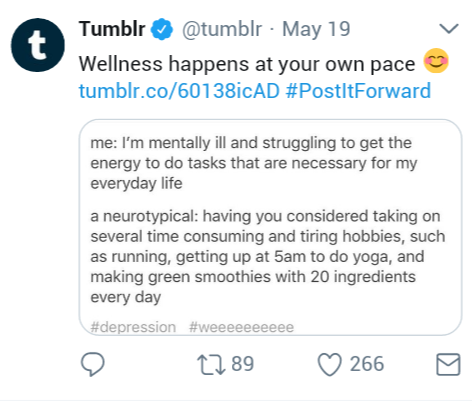
How did the advocacy campaign succeed?
The campaign caught the attention and was supported by some very important people like ex-VP Joe Biden, celebrities like Brittany Snow, Pete Wentz, Jordin Sparks, Elizabeth Banks, Wendy Williams, and First Lady of New York City Chirlane McCray. These personalities helped jump-start the conversation by sharing their personal stories and advice.
The tag was not only going viral on Tumblr, but also across leading social platforms like Instagram, Youtube, and Twitter. Using GIFs made the campaign popular among younger audiences ( their target segment ) and selling merchandise helped increase donations.
Takeaways
- Make your campaign discoverable through eye-catching #HashTags
- Use vivid art and quick-witted content to gain attention
- Make use of GIFs so that teens can relate to it better
- Tag celebrities to help jump-start your campaign
- Sell limited-edition merchandise to leverage the popularity you built
More For You: 15 Research-Backed Advocacy Strategies That Actually Work
Example #2: He for She for advocacy campaigns
UN women initiated the “He for She” campaign for the advancement of gender equality. It seeks to actively involve men and boys in a movement against inequality originally conceived as a struggle for women by women.
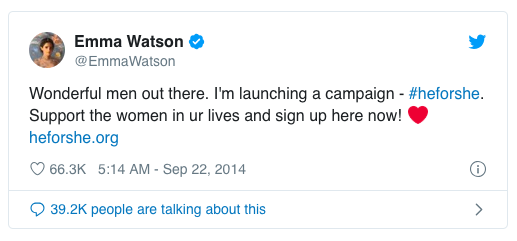
The movement was launched in 2015. Emma Watson, UN Women Goodwill Ambassador, spoke about her own struggles and called upon men and boys to join the movement, the video was widely circulated via social media.
How did the advocacy campaign succeed?
Within 24 hours of its launch, HeForShe saw an 82% increase in Twitter followers, a 305% increase in Facebook likes, and a 3500% increase in Instagram followers. In their video, the UN Women made a call to mobilize the first 100,000 men which was achieved within three days of its launch.
The campaign created more than 1.2 billion conversations over major social media platforms. It had a positive effect on a small village in Zimbabwe. The villagers were committed to turning themselves into better husbands, fathers, and brothers.
The campaign sought active role from Heads of State, corporations, and universities. Former President Barack Obama, actor Matt Damon, and former UN Secretary-General Ban Ki-moon were the first ones to take up the cause.
Takeaways
- Add a deadline for your campaign, it adds a sense of urgency
- Don’t limit yourself to a single channel, be where your audience is
- Promote the positive impact your campaign has had to keep the momentum going
Related Read: 52 Proven Nonprofit Fundraising Ideas to Raise Money in 2019
Example #3: Hashtag Killer for advocacy campaigns
“Water is Life” launched the hashtag Killer campaign to bring clean drinking water to the world’s poorest populations. The organization took a popular tag, used it every day across social media, and gave it an entirely new meaning.
The #Firstworldproblems meme is associated with tweets about trivial life burdens of people such as forgetting the last name of the maid while writing a cheque or leaving clothes in the washer for so long that it smells.
The campaign video features Haitians reciting a list of these “first world problem” tweets, with a series of personalized responses to console those who used the tag on Twitter. The aim was to generate donations to help third-world countries.
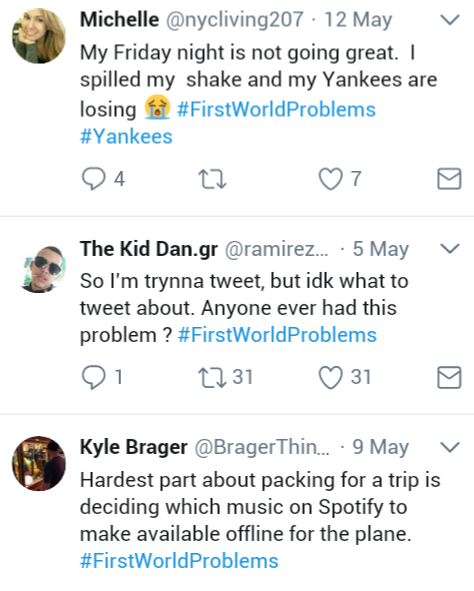
How did the advocacy campaigns succeed?
The campaign generated awareness, and its message was spread all over social media. It won several awards for the innovative use of the popular meme #Firstworldproblems. The YouTube video received over 6 million views and several thousand shares over various social channels.
Celebrities like LMFAO, Christina Milian, Michael Ian Black, and others responded to the trivial tweets, which kick-started the campaign and gave it wide attention.
The aim was met successfully. The organization was able to drill six new wells and install a water treatment plant in Northern Haiti.
Takeaways
- Use popular memes and give them a totally different meaning to tailor your campaign
- Use humor to create videos
- Make sure that your posts are being shared and circulated
Example #4: Big Tobacco Be Like for advocacy campaigns
Truth launched the “Big Tobacco Be Like” campaign to dismantle delusions surrounding social smoking. The video demonstrates how every time an individual tries to rationalize social smoking, Big Tobacco gets paid. The campaign made use of the popular #BeLike meme with humorous spin-offs.
The campaign was led by vine and Instagram stars. 15-second vine-like vignettes showed smokers’ perceptions versus Big Tobacco’s reality. Instagram influencers like Logan Paul, Allicattt, Jerry Purpdrank, and Christian DelGrosso co-produced these humorous videos.
How did the advocacy campaigns succeed?
The campaign ads were smartly launched on popular national television channels so as to target the 12-24 year old demographic. Also, it was seen during the premiere of the popular series ‘The Walking dead’.
Within the first 24 hours, the videos had 4 million views, 1 million per video. By the end of the campaign, the number exploded to 59 million.
Truth saw a 55% increase among young people agreeing with their message. They were able to reduce social smoking among teens successfully.
Takeaways for advocacy campaigns
- Appeal to their emotions
- Make use of popular memes to your advantage
- Get social media influencers to co-produce your videos, making it popular among the younger audience
In every one of the campaigns above, choosing the right channel also played a huge role.
If your audience is younger, then Snapchat or Instagram may work. If you need to engage them in a conversation, then Twitter would work. Quite apart from all of this, the best channel for your organization would be where your target audience is most active.
Key Strategies for Success in Social Media Advocacy
Here are key strategies for success in social media advocacy, distilled from leading nonprofit campaigns and expert insights:
| Strategy | Description | Example Campaigns |
| Use #hashtags effectively | Create memorable, relevant hashtags to unify your message and enhance discoverability. | MeToo, #BlackLivesMatter, #WhyIStayed |
| Collaborate with influencers | Partner with personalities to amplify your reach and tap into their networks. | HeForShe campaign featuring Emma Watson; Truth’s “Big Tobacco Be Like” with Vine influencers |
| Utilize compelling visuals | Employ eye-catching images and graphics to stand out and convey your message effectively. | WWF’s #LastSelfie campaign |
| Create sharable content | Develop content that is easy to share, increasing the likelihood of virality and broader reach. | Truth’s humorous videos in the “Big Tobacco Be Like” campaign |
| Inspire user-generated content | Encourage followers to share their stories, making your campaign more relatable and inspiring | WhyIStayed, Tumblr’s #PostItForward |
So, good luck with your next advocacy campaign! I hope these examples helped in giving you a few ideas on using social media more effectively for your cause!
Featured Image Source: Andrew McMurtrie

